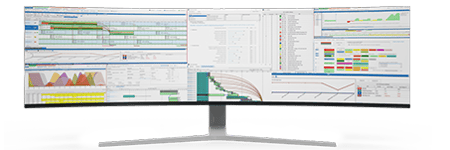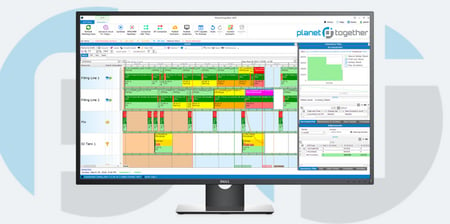Mastering Inventory Control in Packaging Manufacturing
Inventory control is a critical aspect of any manufacturing operation, especially in the packaging industry, where efficient management can make a difference between meeting production schedules or facing costly delays. As a Production Scheduler in a packaging facility, you’re likely balancing multiple priorities—ensuring materials are available, maintaining production flow, and managing cost efficiency. This delicate balance becomes even more achievable with powerful tools that enable a seamless, data-driven approach.
One such approach involves integrating PlanetTogether with enterprise software systems like SAP, Oracle, Microsoft, Kinaxis, or Aveva. This integration offers a unified platform for visibility and control over production schedules, inventory levels, and demand forecasting.
Let’s look into how this integration can empower your role, streamline inventory management, and improve the overall efficiency of your packaging manufacturing facility.

Why Inventory Control Matters in Packaging Manufacturing
Effective inventory control in packaging manufacturing is essential because it:
Prevents Stockouts: Running out of raw materials can bring production to a standstill, leading to delays and unmet orders.
Reduces Excess Inventory: Too much inventory ties up capital and increases storage costs, impacting the company’s bottom line.
Improves Production Flow: Smooth inventory control ensures materials are available precisely when needed, reducing downtime.
Supports Demand Responsiveness: Agile inventory management helps quickly adapt to demand changes, essential in a competitive market.
In packaging manufacturing, raw materials like plastics, paper, and metals can fluctuate in availability and cost. Optimizing these resources without overstocking or understocking is challenging, but integration can make it easier.
![]()

The Role of Integration in Inventory Control
Traditional inventory control systems often fall short when managing complex operations, especially if data exists in silos. By integrating PlanetTogether with major ERP systems like SAP, Oracle, Microsoft Dynamics, Kinaxis, or Aveva, you can unlock comprehensive visibility and control over the entire production process.
What Does This Integration Entail?
The integration of PlanetTogether with ERP systems provides real-time, interconnected data flow between production scheduling and inventory management. This integration:
Synchronizes Data: Automatically updates stock levels as production progresses, minimizing manual entries and errors.
Offers Predictive Insights: Uses data analytics to forecast inventory requirements based on production schedules and market demand.
Enhances Real-Time Decision-Making: Enables quick adjustments based on inventory status, upcoming orders, or production bottlenecks.
Improves Collaboration: Streamlines communication between production and inventory teams, reducing the likelihood of stock discrepancies.
The power of integration lies in uniting scheduling precision with real-time inventory data, enabling a dynamic and adaptable approach to inventory management.

Key Benefits of PlanetTogether Integration for Inventory Control
Real-Time Inventory Visibility
One of the most immediate benefits of integration is gaining real-time visibility into your inventory levels. In PlanetTogether, you can monitor stock levels as production orders progress, making it easier to anticipate shortages or excesses.
Example Benefit: Imagine you’re scheduling a large run of packaging materials. Through the integration, you can see if a particular material is running low, allowing you to adjust the schedule or notify procurement to order more in advance.
Demand-Driven Inventory Forecasting
Integrating PlanetTogether with ERP systems like Kinaxis or Aveva provides access to sophisticated demand forecasting tools. This feature predicts inventory needs based on past trends, seasonality, and current market conditions, minimizing stockouts or overstocking.
Example Benefit: Suppose a holiday season is approaching, and demand for packaging materials spikes. With demand-driven forecasting, you can prepare inventory accordingly, ensuring production meets customer needs without rushing orders or holding excess stock.
Automated Replenishment and Reduced Lead Times
With ERP integration, PlanetTogether can trigger automated replenishment requests when inventory levels fall below a predetermined threshold. This automated process reduces lead times and prevents stockouts, as replenishment orders are placed promptly.
Example Benefit: When scheduling a long production run, the system detects that adhesive materials will run low mid-production. The integration can trigger a purchase order automatically, ensuring a continuous supply without manual intervention.
Cost Optimization through Reduced Overstock
Overstocking ties up resources and incurs storage costs. By aligning production schedules with inventory levels in real time, you can better manage inventory to avoid costly overstocking.
Example Benefit: If demand for a specific product line decreases, PlanetTogether’s integration with an ERP system can signal this change, allowing you to scale back on ordering and prevent excess inventory buildup.
Enhanced Production Flexibility
Flexibility is essential in responding to production changes, such as sudden increases in demand or unexpected production halts. Integrated systems allow you to adjust inventory allocations on the fly, ensuring production schedules remain unaffected.
Example Benefit: A large client places an urgent order. With real-time insights from the integration, you can reallocate materials from lower-priority jobs to meet the urgent need, minimizing the risk of disrupting production schedules.

Leveraging Specific ERP Integrations with PlanetTogether
Depending on your facility’s ERP system, here’s how integration with PlanetTogether can bring unique inventory control advantages:
SAP Integration
SAP’s robust inventory modules align seamlessly with PlanetTogether’s scheduling capabilities. Real-time stock updates, combined with SAP’s Material Requirements Planning (MRP), ensure that production orders are fulfilled promptly. SAP’s forecasting tools also enhance PlanetTogether’s ability to plan based on accurate demand data.
Oracle Integration
Oracle’s cloud-based solutions allow for dynamic inventory management, offering predictive analytics that further enhances PlanetTogether’s scheduling accuracy. Oracle’s IoT capabilities provide additional inventory insights, such as tracking materials throughout the facility, which can be integrated into PlanetTogether to streamline inventory control.
Microsoft Dynamics Integration
Microsoft Dynamics supports automated workflows and data synchronization between departments. When integrated with PlanetTogether, this ERP system facilitates enhanced communication and enables rapid scheduling adjustments based on real-time inventory levels. Microsoft’s Power BI can also be linked to generate insightful reports, which help refine inventory strategies.
Kinaxis Integration
Known for its advanced supply chain analytics, Kinaxis integration can transform PlanetTogether’s approach to inventory forecasting. With Kinaxis, production scheduling is optimized for demand variability, allowing you to handle sudden order changes with ease. Kinaxis’s “what-if” analysis tools can also help you proactively prepare for inventory shortages or surpluses.
Aveva Integration
Aveva’s focus on process optimization aligns well with PlanetTogether’s scheduling tools, particularly for industries where precision and timing are critical. Aveva’s integration supports automated inventory monitoring and predictive maintenance, helping avoid disruptions that affect inventory needs and production schedules.
Best Practices for Production Schedulers: Maximizing Integration Benefits
Set Clear Inventory Thresholds: Define minimum and maximum inventory levels for each material. By using the ERP integration, you can automate alerts when inventory nears these limits, ensuring a balanced supply without constant manual checks.
Regularly Update Demand Forecasts: Keep forecasts current by leveraging PlanetTogether’s analytics with ERP data. Regular updates prevent surprises, especially during high-demand periods.
Use Predictive Analytics for Better Inventory Planning: Integrated predictive analytics help forecast inventory needs based on historical data and market trends. Make this a regular part of planning to avoid overstocking and stockouts.
Engage in Cross-Department Collaboration: Integrated systems foster collaboration across departments. Meet regularly with procurement and production teams to align on inventory needs and avoid bottlenecks.
Leverage “What-If” Scenarios for Contingency Planning: Use ERP tools like Kinaxis’s “what-if” scenarios to prepare for potential disruptions. These scenarios help anticipate material shortages and develop alternative scheduling plans.
For Production Schedulers in packaging manufacturing, mastering inventory control can lead to streamlined production schedules, reduced operational costs, and higher customer satisfaction. Integrating PlanetTogether with ERP systems like SAP, Oracle, Microsoft, Kinaxis, or Aveva provides real-time data insights, predictive analytics, and automation that transform inventory control from a reactive task to a proactive strategy.
By embracing this integration, you’re setting your facility up for operational success, agility, and resilience in a competitive market. The result? More efficient production runs, satisfied clients, and a leaner, cost-effective approach to managing inventory in the packaging manufacturing landscape.
Are you ready to take your manufacturing operations to the next level? Contact us today to learn more about how PlanetTogether can help you achieve your goals and drive success in your industry.
Topics: PlanetTogether Software, Integrating PlanetTogether, Real-Time Inventory Visibility, Packaging Manufacturing, Cost Optimization through Reduced Overstock, Demand-Driven Inventory Forecasting, Automated Replenishment and Reduced Lead Times, Enhanced Production Flexibility, “What-If” Scenarios for Contingency Planning




















LEAVE A COMMENT